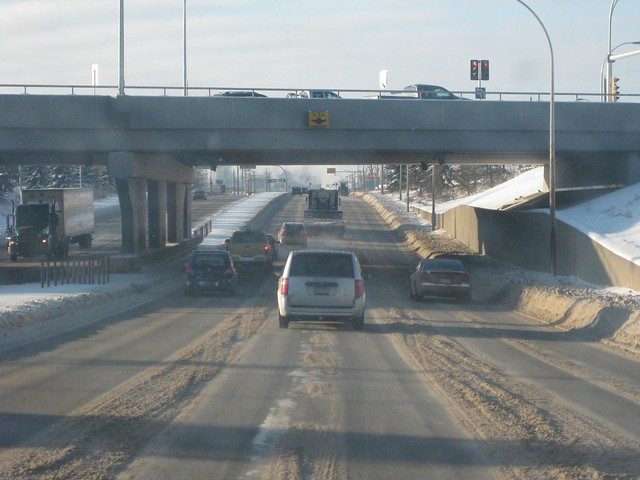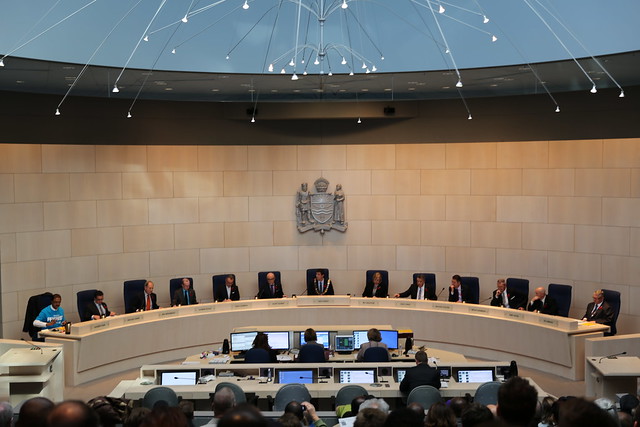It’s Committee week!
Agendas for upcoming City Council meetings are generally released on Thursday afternoons. I like to take a look to see what Council will be discussing, and I figured I should share that here. Below you’ll find links to the meetings taking place next week, as well as links to and thoughts on some agenda items that caught my eye.
Monday, February 2, 2015
Council starts the week with a Community Services Committee Meeting scheduled to take place from 9:30am until 5:30pm. There are three reports on the agenda, all of which require approval by Council.
Accessibility Advisory Committee
This report is for bylaw 17002 which will replace bylaw 13194 and change the name from the Advisory Board on Services for Persons with Disabilities to the Accessibility Advisory Committee (because committees are advisory in nature). Apparently a survey of other municipalities found that 70% use the name “Accessibility Advisory Committee”. It also follows the new standard for establishing bylaws of this nature, and would allow the Chair to participate in the shortlisting process for recruiting new members.
Amendment to the Public Places Bylaw
This bylaw is all about the decision to prohibit smoking in Churchill Square. Bylaw 17004 is ready for three readings and enables the City Manager to designate certain outdoor spaces as no smoking areas. What’s interesting is that Administration through the City Manager will now have the power to designate any area as a no smoking area, not just Churchill Square. If the three readings pass, the bylaw would come into effect on April 15, 2015.
Amendment to the Community Standards Bylaw for Backyard Fire Pit Control
This amendment, bylaw 17031, would prohibit outdoor fires during air quality advisories. The fine for violation will be $250, increasing to $500 for subsequent offences. Less than ten violation tickets were issued in 2014 for outdoor fire offences.
Delayed Reports
Three reports have been rescheduled for future meetings:
- Fire Pit Enforcement Options – March 23, 2015
- EPS: Policing Expenditures for Non-Residents – March 23, 2015
- Options for prohibiting smoking at all outdoor City-owned facilities – April 20, 2015
Tuesday, February 3, 2015
Council will hold its next Executive Committee Meeting on Tuesday, scheduled to run from 9:30am until 5:30pm. There are nine reports on the agenda, three of which require Council approval. Here are some agenda items that I was particularly interested in:
Policy on Construction Hoarding Standards
I have been concerned about construction hoarding, especially throughout downtown, for a while now. As a pedestrian, the current approach could be described as lacking, at best. Council has heard the concern and complaints from the community and a new policy on construction hoarding has bee proposed.
“Urban densification and a vibrant public realm are key elements to increasing the livability and sustainability of our city. As the city grows, it is crucial to maintain and improve the walkability and vibrancy of the public realm without hindering development in areas best suited for densification. The City of Edmonton promotes the use of construction hoardings that balance the interests of all parties in order to achieve pedestrian safety, transportation mode equity, vibrant streetscapes and community.”
This is a great step forward. The City will develop a template for hoarding agreements and set of standard clauses. They are reviewing the Safety Codes Permit bylaw and other applicable bylaws and will make recommended amendments as appropriate.
Most importantly, the importance of the pedestrian appears to have been realized:
“A review of Edmonton’s current hoarding fees revealed that the amount charged for the
occupation of road is nearly four times more per square metre than for sidewalk. This creates an incentive to keep the road clear while occupying the sidewalk. Administration is working to change fees to reflect the importance of sidewalks in high pedestrian areas and acknowledge the City’s commitment to encourage active transportation.”
Incentives for public art are also being explored, which could make hoarding much more attractive. On top of that, improvements for public notification about road and sidewalk closures have been requested and will be considered.
This is really great news!
Direct Control Zoning for the Protection of Historic Character
Back in November, Council asked for a report on areas that may be suitable for DC zoning to protect historic character. The report outlines some definitions for heritage districts and the criteria used to identify heritage properties and character areas. These are typically 50 years or older. Edmonton currently has seven identified heritage character areas:
- Westmount Architectural Heritage Area (1997)
- Strathcona Historical Commercial Area (1998)
- Historic West Ritchie Area (2011)
- Garneau Special Character Residential Area (1982)
- Viewpoint Special Character Area (1982)
- Oliver Special Character Area (1997)
- The Brickyard at Riverdale (2001)
Additional potential heritage character areas have been identified in McCauley, Alberta Avenue, Westmount, Inglewood, Glenora, Jasper Place, and Beverly Heights.
Edmonton’s heritage program was established in 1981 “in response to the loss of a number of key historic resources in Downtown.”
Building Canada Fund Projects
This report outlines the projects that could be submitted to the federal government under the new Building Canada Fund. The National Infrastructure and the Provincial-Territorial Infrastructure components of the fund provide a combined $14 billion for projects, with a variety of rules and restrictions that much be followed.

Yellowhead Trail by Brittney Le Blanc
The proposal is for Yellowhead Trail Improvements (Stages 1-5) to be our city’s priority under the National Infrastructure component. Five projects would be designated under the Provincial-Territorial Infrastructure component: LRT Expansion, Key Grade Saparations (50 Street and 75 Street underpasses, Manning/Meridian Interchange), Neighborhood Flood Mitigation Program, Fort Edmonton Park Utility Infrastructure Upgrades, Edmonton Energy and Technology Park.
The City’s portion of those projects would be funded using tax-support debt. Land acquisition is not eligible for funding under the Building Canada Fund, and that is expected to make up more than $200 million of the Yellowhead Trail project costs, so that’s a concern.
TOD on the Coliseum LRT Station and Northlands Site
This report is an update on plans for transit oriented development around Coliseum LRT Station. The high level update is that plans are on hold until the Northlands Arena Strategy Committee (which I am a member of) makes it recommendation on the future of Rexall Place and until the Northlands Board of Directors completes its Strategic Planning Process. The City is meeting regularly with Northlands and have agreed to “evolve a partnership relationship and to enhance communication and collaboration.”
Other
- The first item of business is an update on consultation held with Belgravia and McKernan communities to “clarify understanding of policy related to potential rezonings” from RF1 to RF3 to facilitate small scale neighbourhood infill within 400 metres of the McKernan/Belgravia LRT Station.
- Council will be voting on a recommendation to designate the Cameron Block located at 10543 97 Street as a Municipal Historic Resource, and to provide about $170,000 in funding for the project.
- One report provides an update on the effects of amendments to the Zoning Bylaw for Major and Minor Alcohol Sales Uses. Liquor stores cannot be within 500 metres of one another, but when that regulation came into effect in 2007, many existing stores became legally non-conforming.
- An update on the “Finding Common Ground” research project that began back in January 2013 will be discussed. The goal is to “find ways to address the root causes for conflict” in non-market housing developments.
Delayed Reports
Two reports have been rescheduled for future meetings:
- Possible Amendments to Procedures & Committees Bylaw 12300 – February 24, 2015
- Public Hearing Process (Henderson/McKeen) – April 21, 2015
Wednesday, February 4, 2015
The final meeting of the week will be the Transportation Committee Meeting on Wednesday from 9:30am until 5:30pm. Here are the four reports that will be discussed:
Raising Awareness for High Collision Areas
This report follows on from a request made back in November to explore how to raise awareness of high collision locations. It summarizes six measures that may increase driver awareness of those locations:
- Static Roadside Signs
- Dynamic Roadside Signs
- Pavement Markings
- Intersection Safety Devices (cameras)
- Improve Signal Visible Measures
- Public Engagement and Communications
The report says that static roadside signs “have been shown to have minimal effectiveness on collision reduction.” The City is proposing to update the signs to include more information on what action needs to be taken (slow down, exert caution when merging, etc.). Dynamic roadside signs are like digital message boards or signs that show a driver’s speed. The report says that for speed limit compliance, “Driver Feedback Signs are effective as a speed management tool.”

Pavement markings can be effective, but less so in Edmonton where the roads are covered in snow for so much of the year. Apparently cameras at intersections “showed significant reductions” in collision severities and types. The report says the best way to improve signal visibility is to put it overhead, a measure which “can reduce collisions by 30 to 35 percent.” Finally, the report says public engagement campaigns can be effective, such as a program that resulted in a 15 percent reduction of red-light running vehicles.
Expropriation of Lands for the Valley Line LRT
Council approval is required to begin the expropriation process, so I expect the Committee to make that recommendation as a result of this item. By starting the process, the City will be able to negotiate with property owners to reach a settlement or a Section 30 Agreement (which allows the Land Compensation Board to determine the compensation when a settlement between the two parties cannot be reached).
The required expropriations and temporary and permanent construction easements for this stage are all the land around Mill Woods Town Centre (Lot 3, Block 6, Plan 0022000).
Open Tenders of $20 million or greater
Bylaw 12005 requires that open tenders greater than $20 million require Committee approval. This report highlights one tender, number 927871, which is for “Dust-free Mechanical Street Sweeping and Related Services”. The value of the project is between $30 million and $50 million.
Eliminating Railway Whistling at Public Crossings
Back in November, Councillor Esslinger asked for information about how to eliminate railway whistling at public crossings in the densely populated areas of north Edmonton, particularly late at night. The report says that train whistling is required under Transport Canada’s operating rules, but that an exemption could be sought if the City and CN worked together to apply for one. It would require a “whistling cessation study” to be completed at an approximate cost of $50,000 per location. Depending on the outcome of the study, crossing upgrades would likely be added on top of that cost. There is currently no budget allocated for any of this.
Delayed Reports
Eight reports have been rescheduled for future meetings:
- Escalators at LRT Stations (Walters/Iveson) – February 25, 2015
- Traffic Noise from the Anthony Henday (Oshry) – February 25, 2015
- Low Income Transit Pass Pilot – April 22, 2015
- Public Involvement Plan – Barriers to Participation – May 6, 2015
- Community Traffic Management Plan Pilot (Prince Charles & Pleasantview) – May 6, 2015
- Community Traffic Management Process Possible Changes – May 6, 2015
- Opportunities for Commercial Development in Future LRT/Transit Infrastructure – June 17, 2015
- Bike Lane Removal (Nickel) – June 17, 2015
Wrap-up
It’s not up yet, but I expect an overview of everything that happened this week to be on the Mayor’s Week in Review Blog soon.
You can keep track of City Council on Twitter using the #yegcc hashtag, and you can listen to or watch any Council meeting live online.

